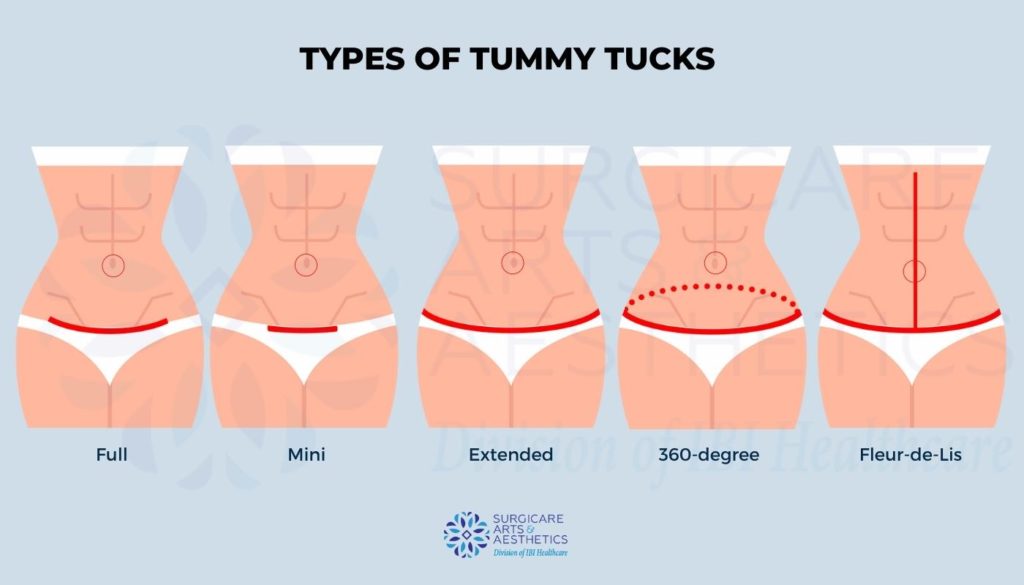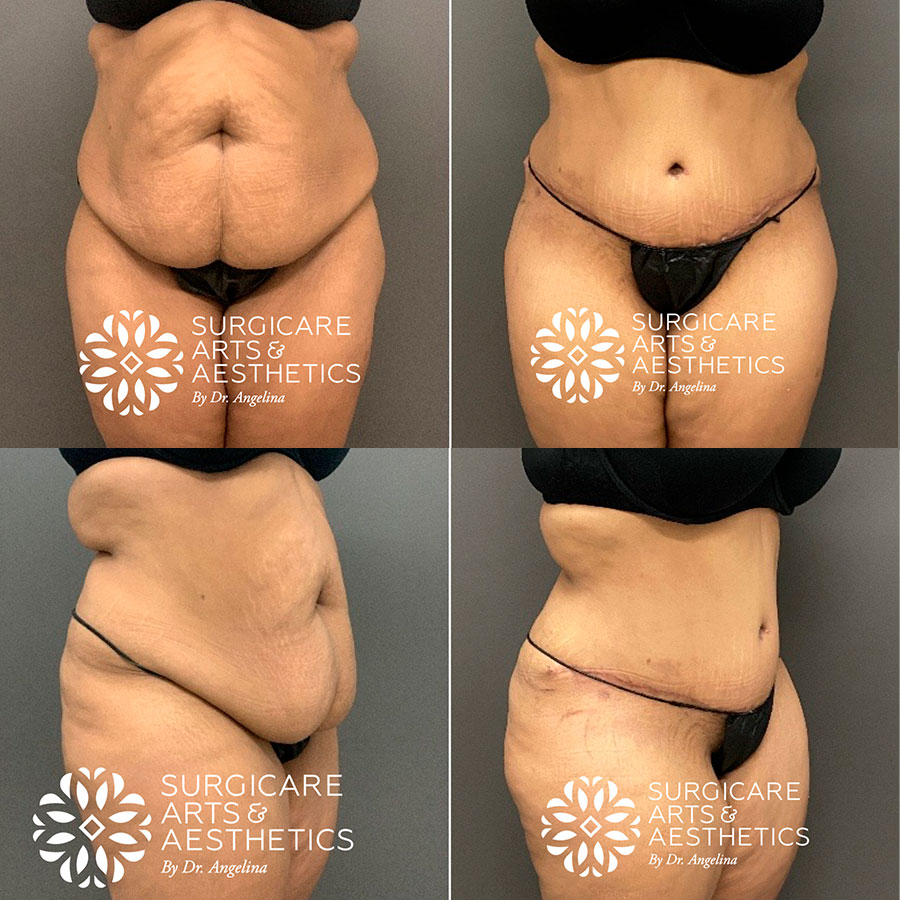Tummy Tuck Scars: Position, Healing and Treatment
If you have had, or are planning to have, a tummy tuck you are among the 130,000+ people to have the procedure this year. Any surgical procedure that involves an incision is going to leave scarring and most people desire to minimize any scarring. Most tummy tuck patients feel that the results of their tummy tuck largely offset the downside of having a scar. If you want to know what you can do to minimize your tummy tuck scars, then keep reading.
Incisions After Tummy Tuck
The incision most associated with a tummy tuck is horizontal and runs between the hip bones as well as a tiny incision near the belly button. The mini tummy tuck incision is shorter and resembles a C-section incision just below the bikini line. Patients who have had multiple pregnancies or huge weight losses and have a lot of excess skin may require an incision that is shaped like an upside-down T and runs both vertically and horizontally from the lower breastbone to the pubic bone.

Does A Tummy Tuck Leave Scars?
Yes, tummy tuck surgery normally leaves some visible scarring. The surgeon must create abdominal incisions to remove the extra skin, fat, and to tighten the abdominal muscles. Once these repairs have been made, the surgeon sutures these incisions using care to place them in the most inconspicuous locations as possible. Usually, with proper care and over time, these scars will fade to be much lighter.
Stages of Tummy Tuck Scars Healing
- Immediately After – Swollen, tender, red, and possibly oozing might occur. The scars require frequent cleaning and possible antibiotic ointment to prevent infection.
- At One Month – The patient’s skin tone determines color but normally at this point, the incision site is dark red or brown. It may be a bit uneven or lumpy, slightly raised, and partially swollen.
- At 2 Months – Incisions are normally totally healed at this point. They will most likely be red or purple and slightly raised. They may still be a bit swollen but this will subside in the coming months.
- At 3 Months – The inflammation and puffiness should be going away and the incision site should seem flatter.
- At 6 Months – The scars should be fading by now and not appear to be a prominent red color. It may appear a rosy pink or light brown. As time goes on, the color will fade even more.
- After a Year – The swelling should be completely gone and the scars should have faded significantly.
How Bad Will Your Abdominoplasty Scars Be?
There are a few factors that will determine the severity of scarring due to the incisions made during a tummy tuck. Each patient’s scarring can differ due to:
- Skin type and genetic predisposition to scarring;
- The technique used and expertise of the surgeon;
- Diligence with which surgeon’s aftercare instructions are followed;
- Post-operative complications, e.g. infection.
A skilled surgeon will take care to position the incision to reduce visible scars as best as they are able. You can take steps before and after surgery that will help your incisions heal faster with less noticeable scarring. Eating healthy, refraining from smoking, and taking good care of yourself before surgery and after will help you avoid complications that can result in noticeable scarring. Keeping your healing incisions out of the sun for at least a year will also help avoid extensive scarring.
About 2 weeks after your surgery, you can begin using some at-home remedies to help alleviate scarring. After a few months, when your incision has completely healed, some cosmetic treatments can make scars even less noticeable.

6 Ways To Hide or Treat Your Tummy Tuck Scars
A tummy tuck scar will never go away completely but here are some ways to lessen its appearance.
1. Taping For Tension
Typically dissolvable sutures placed under the skin are used to close up a tummy tuck incision and then the incision is covered with sterile strips or paper tape. This provides both protection and relieves some of the tension that is on the sutures. The tape also provides light pressure along the incision and this has been shown to help minimize scarring as well. Patients can continue to tape the incision as part of their aftercare routine for about 6 weeks changing the tape every week.
2. Topical Creams and Ointments
About 2-6 weeks after surgery you can begin using a simple moisturizing cream containing vitamin E or one of the many specialty scar creams on the market. None of these creams will miraculously remove the scar but they help minimize them. After about 6 weeks you can use some of the more advanced creams containing silicone or hydroquinone which lightens the skin.
3. Energy-Based Treatments
After about a year, your scar will pretty much look the way it is going to stay. If the way it looks makes you feel self-conscious there are professional treatments that can help improve this. Laser resurfacing treatments can smooth the texture of scars making them less noticeable. Light-based treatments such as CoolPeel™ can lighten any darker-pigmented skin and reduce redness to improve the way scars look. Radiofrequency devices like InMode Fractora or Morpheus8 are safe to use in scar revision for all skin phototypes in contrast to laser devices. All these treatments work great for scarring but you will probably need a series of treatments to obtain the desired results.
4. Microneedling
Microneedling uses tiny surgical-grade needles to create micro-injuries to your skin which stimulates your skin’s collagen and elastin production to heal these injuries. When used on a tummy tuck scar, it can reduce the appearance of the scar and make the skin firmer and smoother. A series of microneedling treatments can result in a flat, softened, tummy tuck scar that is much less noticeable.
5. Microdermabrasion
Most commonly microdermabrasion is used in treating acne scars and it does it very well. However, the treatment can reduce the appearance of surgical scars too by mechanically removing the superficial skin layers and promoting skin self-rejuvenation.
6. Tattoos To Hide Tummy Tuck Scars
Some patients choose to cover their tummy tuck scar with a tattoo which is a very creative way to camouflage scarring. Another recently offered solution is the use of permanent cosmetics to disguise surgical scarring by matching an ink color to the skin surrounding your scar and “filling it in”. Finding a reputable professional is crucial to ensure the desired outcome.
Scarring from a tummy tuck is inevitable but you do have options to reduce how noticeable it is.
Angelina Postoev, MD, FACS, a triple board-certified cosmetic surgeon, and Christopher Ibikunle, MD, FACS, offer treatments to reduce the appearance of surgical scars, including tummy tuck scars in Lawrenceville, Suwanee, Johns Creek, Buckhead, and the surrounding areas of Atlanta, Georgia.







